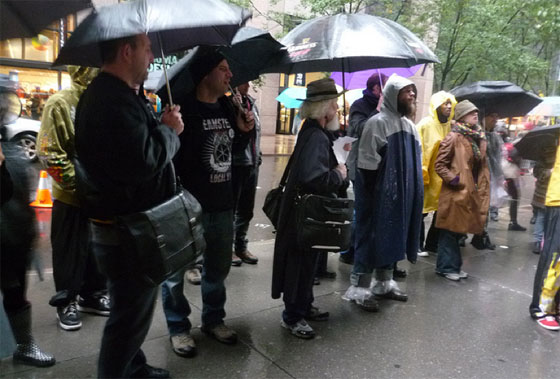
From the Occupy Museums occupation Thursday
Is Occupy Museums a splinter group or a faction? Does it serve the greater cause of the OWS protests, or does it needlessly divert resources? It’s a question our commenters have been hashing out on “Why Splinter Groups Don’t Take Away From Occupy Wall Museums“. I tend to fall on the side of faction — AFC’s Will Brand made a compelling argument for this last week — but there’s more than one perspective on this. A few highlighted comments from the thread follow. First, a handy metaphor from Deborah Fisher, executive director at A Blade of Grass:
I think some of these cultural spinoffs work and some don’t. I am into OWS and Occupy Museums because they are hitting the right scale and understanding what we are all forced to participate in. You can’t stop participating in the economy at large. You can’t help but situate your knowledge of culture in terms of large institutions like museums–we have all bought into a system where museums function as art repositories and generators of meaning and value.
These are good arenas for understanding how to own membership and act like a citizen in the face of an enormous, abstract power structure. Occupy Artworld or Occupy Chelsea don’t hit this appropriate scale and don’t harness this sense of citizenship. They don’t fail because galleries are not good targets. They fail because artists are not forced to participate in the gallery system. In fact, the overwhelming majority of artists *don’t* participate in the gallery system in a meaningful way–they are excluded.
It’s the difference between one bunch of high school students protesting the dungeon-like quality of the cafeteria, and another protesting the popular kids, who happen to get the only window seats in the cafeteria. The first group is powerful because they understand what they are citizens of. The second group is bitching about power, and the fact that they don’t have any.
Deborah Fisher, A Blade of Grass
It’s a position we like, because it’s a lot like our own. John Powers, of Star Wars Modern, asked in another thread whether art’s attitude towards its own primacy wouldn’t hurt the movement as a whole:
Would it kill artists to stand behind a cause, rather than insist on being front-and-center of attention?
Is it so terrible to ask those within the artworld to use their talents for drawing attention, to draw attention away from themselves, and to instead use their talents on behalf of a cause greater than the artworld?
To be clear: I think most people in the artworld that I keep track of (via twitter, blogs, and socially), have done exactly that. The artworld rallied early and loudly behind the OWS protestors. AFC and other art sites have done a great job of reporting on the Occupy movement.
But no, splintering is not good for a movement. The Religious Right has been so effective because it is not a splinter. It is a faction — they stand with the rest of the Right, adding their mass and energy to the greater cause. Ralph Nader was a splinter and he delivered the White House to George W Bush — way to go Ralph. If splintering was such a good thing the would-be museum occupiers would not have felt it necessary to distance themselves from “Occupy 38” – which is exactly what they did.
To which Fisher expressed skepticism:
I see what you’re saying but just because the Religious Right has had a successful strategy for awhile, that doesn’t mean it’s the only successful strategy.
I think the Occupy movement’s success is based in large part on its flexibility and adaptability, on the fact that it’s organized around a way of being that promotes discourse and multiplicity rather than one set of answers. At Zuccotti Park the Ron Paul people are standing next to the guy decrying gun violence and the woman with a lot of debt and the guy who wants actual finance reform, and everybody is getting health care from the medic and getting food from the kitchen and sharing books at the library and taking shifts at maintenance. And this works. They are creating a demos that can sustain multiple conversations.
I question your attachment to messaging and the notion that this is a zero-sum game.
Powers:
Deborah, the odd bedfellows you are describing making up the crowd at Zuccotti Park are factions, not splinters. They are there at the park, not off on their own adventures. The Ron Paul guys (they are always guys) no doubt count themselves as part of the 99%. The reason they are there is to make common cause not a whole new cause.
Fisher:
I think the problems you’re pointing to are design features of a movement that is not technically a protest. A protest takes two bodies and pushes them against one another in a strength contest. Structurally, the Occupy movement looks more like a net or a web that seeks to expand rather than push. It’s not engaged in a strength contest.
The OM folks are not off on their own adventure or making it all about them. They are seeing a relationship between two kinds of problems and exploring that relationship with the backing and structure of the GA. They’re expanding the net. This kind of exploration, relationship-building and meaning-making feels like exactly what the movement is about.
Having spent a good deal of time reading the listserve, I’d say Fisher’s position is dead on. Most Occupy Museums participants are very much involved with the larger movement, which is ultimately the core of the movement.
In other news, the web analogy Fisher uses is not uncommon; I’ve similarly seen a lot of comparisons, that posit the structure of OWS as similar to the Internet. That’s an analogy that doesn’t quite match up though, so we’ll be discussing that later in the week.


Comments on this entry are closed.